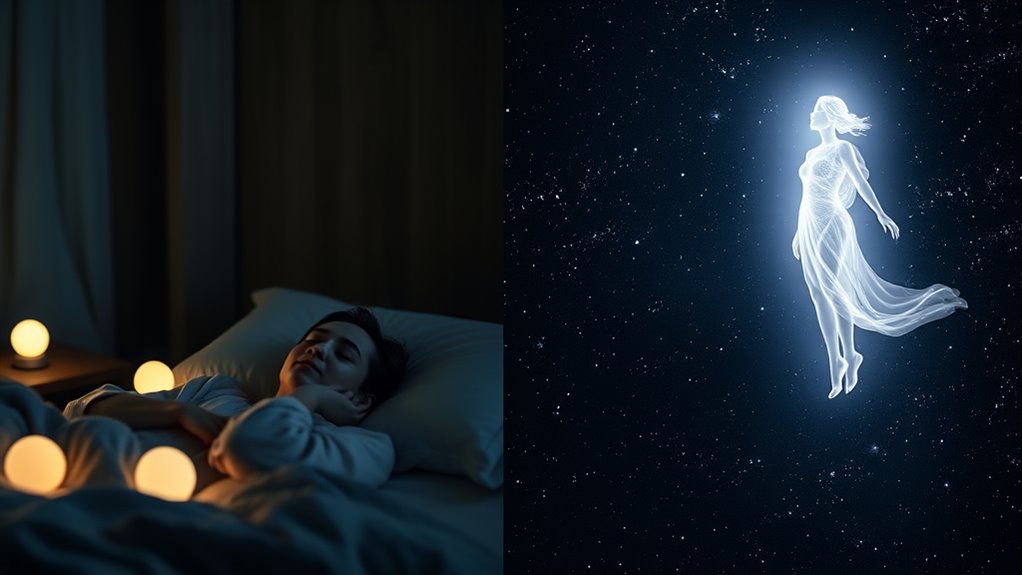Lucid dreaming happens while you’re asleep, with awareness inside the dream, allowing you to control the dream environment. Astral projection involves consciously leaving your physical body and exploring non-physical planes, often through focused relaxation or visualization. While both experiences involve heightened awareness, lucid dreaming occurs within the dream state, and astral projection takes you outside your physical form. Want to discover how they differ and what makes each unique? Keep exploring to find out more.
Key Takeaways
- Lucid dreaming occurs during sleep with awareness within the dream, while astral projection involves conscious separation from the physical body outside sleep.
- Lucid dreams are vivid dream states where one controls the environment; astral projection is an out-of-body experience navigating non-physical planes.
- Techniques for lucid dreaming include reality checks and sleep paralysis awareness; astral projection uses visualization, meditation, and deep relaxation.
- Lucid dreaming remains within the dream realm, whereas astral projection involves awareness beyond the physical realm in different dimensions.
- Lucid dreaming is mainly a psychological experience; astral projection is often considered a spiritual or metaphysical journey.

Many people are fascinated by the idea of exploring different states of consciousness, but two concepts often come up: lucid dreaming and astral projection. While they might seem similar at first glance, they are quite distinct experiences, each with its own process and significance. Understanding these differences can help you steer your own explorations of the mind more effectively.
Lucid dreaming happens within the domain of your sleep. During a typical dream, you’re often unaware that you’re dreaming, but in a lucid dream, you gain conscious awareness that you’re asleep and dreaming. This realization allows you to consciously control or influence the dream environment, making the experience more vivid and intentional. However, achieving lucidity can sometimes be interrupted by sleep paralysis, a state where your body remains temporarily immobile as you shift between wakefulness and sleep. Sleep paralysis can be frightening because you might experience hallucinations or a sense of suffocation, but it’s actually a normal part of the sleep cycle. When it occurs, your consciousness may be partially active, and you might find yourself aware of your physical body while your mind is in a dream state. This heightened state of conscious awareness during sleep can be confusing but also offers an opportunity to practice lucid dreaming, as recognizing sleep paralysis can help you differentiate between waking and dreaming states. Additionally, consistent practice and techniques such as reality checks can improve your ability to become lucid more frequently.
Astral projection, on the other hand, involves a conscious separation of your “spirit” or consciousness from your physical body. You actively intend to leave your body and explore non-physical planes, often with the belief that your consciousness can travel freely outside of the physical world. Unlike lucid dreaming, which occurs within the dream state, astral projection is considered an out-of-body experience where the mind attains a heightened level of conscious awareness—often described as a different level of existence. Many who attempt astral projection focus on techniques like visualization, meditation, or deep relaxation to reach this altered state. It’s believed that during astral projection, your awareness remains intact, but you’re consciously navigating an entirely different plane of reality. This experience requires a different mindset than lucid dreaming; it involves a deliberate, focused effort to transcend the physical domain rather than simply becoming aware within a dream. Some practitioners also believe that techniques like meditation and visualization can facilitate the transition into astral travel.
Frequently Asked Questions
Can You Consciously Control Both Lucid Dreaming and Astral Projection?
Yes, you can consciously control both lucid dreaming and astral projection. With practice, you develop mind control and increase your dream awareness, allowing you to steer your experiences intentionally. In lucid dreaming, you realize you’re dreaming and can manipulate the dream world. During astral projection, you intentionally separate your consciousness from your body. Both require focus, patience, and techniques that strengthen your ability to control these altered states.
Which Experience Feels More Real: Lucid Dreaming or Astral Projection?
You’ll find that astral projection often feels more real because of heightened sensory awareness and intense dream quality. During astral projection, your senses seem sharper, making the experience vivid and tangible. In contrast, lucid dreaming, while controllable, tends to have lower dream intensity and less sensory detail. This difference makes astral projection feel like an actual out-of-body experience, whereas lucid dreams remain immersive but slightly less realistic.
Are There Physical Risks Associated With Astral Projection?
Think of astral projection as sailing a delicate boat across unseen waters—it’s generally safe if you stay aware. There are no significant physical safety or health concerns linked to it, as it’s an energetic experience rather than physical. However, if you’re prone to mental health issues, you might want to approach with caution. Overall, you won’t face physical risks, but trusting your intuition helps keep the journey smooth.
How Can Beginners Distinguish Between the Two Experiences?
To tell apart a lucid dream from an astral projection, focus on your consciousness awareness and dream recall. In a lucid dream, you realize you’re dreaming within your mind, often feeling like a vivid, controllable dream. During astral projection, you feel a sense of leaving your physical body, with heightened awareness and a more external perspective. Practice mindfulness and record your experiences to improve your ability to distinguish between the two.
Do They Have Different Spiritual or Psychological Benefits?
You might wonder if they offer different spiritual or psychological benefits. In reality, both experiences can deepen your meditative benefits and promote emotional healing, but they do so in unique ways. Lucid dreaming often enhances self-awareness and problem-solving, while astral projection might connect you to a broader spiritual dimension. Exploring both can open profound insights and personal growth, leaving you intrigued about what lies beyond your waking consciousness.
Conclusion
While lucid dreaming and astral projection often get lumped together, they’re distinct experiences—you don’t necessarily need to believe in the supernatural to explore them. Some skeptics argue they’re just vivid mental states, but whether you see them as spiritual or psychological, both can deepen your understanding of consciousness. So, don’t dismiss these practices; instead, approach them with curiosity and critical thinking, opening the door to personal growth and fascinating insights beyond everyday perception.








